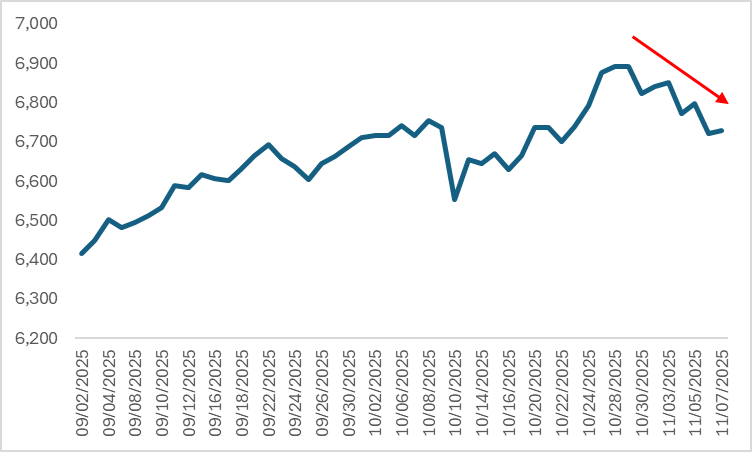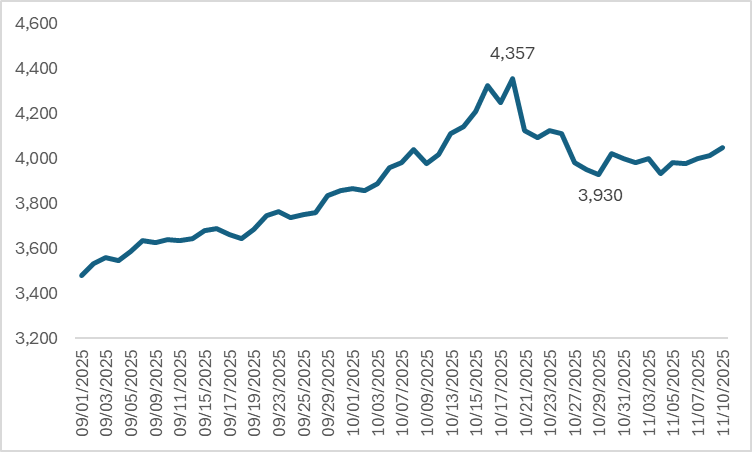U.S. Ends Shutdown: “Dual-Engine Drive of Stocks and Gold” as the Optimal Strategy
1. Introduction
TradingKey - According to reports on 9 November, bipartisan leaders in the Senate have reached an agreement to fund the government through 30 January next year. They also plan to hold a vote on the Affordable Care Act in December, marking an imminent end to the government shutdown threat. The agreement includes revoking Trump’s decision to dismiss federal employees and ensuring funding for the food stamp program through fiscal year 2026.
Judging solely from the end of the shutdown, as uncertainty eases, safe-haven demand declines and economic expectations recover, this scenario is bullish for U.S. stocks and bearish for gold. However, this does not mean that the subsequent trends of U.S. stocks and gold will diverge. Against the backdrop of elevated stock market valuations, an unchanged broader trend of economic slowdown, and the ongoing de-dollarisation process, U.S. stocks still face downside risks, while gold retains upside potential. After comprehensive consideration, our investment strategy is the "dual-drive of stocks and gold" — allocating to U.S. stocks and gold in a rotating manner at a fixed ratio. If U.S. stocks outperform gold in gains, or if stocks rise while gold falls, investors need to rebalance their portfolios by selling some U.S. stocks and buying gold, and vice versa. Through the rebalancing strategy, investors can achieve buying low and selling high for both assets.
On specific dimensions, investors should make reasonable asset allocation based on their own type (passive or active). In the U.S. stock market, passive investors can opt for large-cap ETFs such as SPY and QQQ. Active investors may focus on sectors and individual stocks that benefit from the end of the U.S. government shutdown, including Northrop Grumman (NOC) – a leader in the defence sector, Walmart (WMT) in the consumer sector, JB Hunt Transport Services (JBHT) in the infrastructure sector, and Delta Air Lines (DAL) in the aviation sector. For the other asset allocation dimension of the "dual-engine" strategy, investors can allocate to gold ETFs like GLD, or individual stocks related to the gold sector, such as Newmont Corporation (NEM) and Barrick Gold Corporation (B).
2. Impact on U.S. Stocks
2.1 Broader Stock Market
The bullish impact of the U.S. government shutdown ending on the U.S. stock market stems from the triple logical resonance of eliminated uncertainty, restored liquidity, and improved economic expectations, which can be elaborated in three aspects:
First, market risks are removed, and confidence is rebuilt. Investors fear uncertainty far more than the event itself, and the more than 40-day shutdown has severely damaged consumer confidence. The University of Michigan's U.S. Consumer Sentiment Index dropped from 53.6 in October to 50.3 in November, significantly lower than 71.8 in the same period last year. Recently, major market indices such as the S&P 500 have trended downward due to emotional drag (Figure 2.1). The end of the shutdown indicates the breaking of the partisan game deadlock, and the previously suppressed market sentiment will recover.
Second, liquidity pressure has eased. During the shutdown, approximately $1 trillion accumulated in the U.S. Treasury General Account could not enter the market, creating a significant liquidity bottleneck. After the government reopens, these funds will be gradually released. Coupled with expectations that the Federal Reserve may restart balance sheet expansion, this will jointly inject liquidity into the market and provide capital support for U.S. stocks.
Finally, as economic activities return to normal, fundamental expectations are improving. The shutdown disrupted sectors like food assistance and air transportation, while delays in key economic data releases hindered corporate decision-making and profit outlooks. Following the restart, with the resumption of federal spending and normalised data publication, market focus can shift back to core fundamentals such as corporate profitability, and sectors previously dropped due to external disruptions are expected to see valuation recovery.
Figure 2.1: S&P 500 Index

Source: Refinitiv, TradingKey
2.2 Sectors and Individual Stocks
After the U.S. government ends the shutdown, the defence, consumer, infrastructure, aviation sectors are expected to benefit the most. The defence sector was previously weighed down by delayed contract payments — with the shutdown over, order fulfilment and fund disbursement will accelerate. Northrop Grumman (NOC), a leading player, may lead the gains thanks to its long-term defence contracts and stable cash flow. The consumer sector will benefit from the consumption rebound as federal employees return to work. Walmart (WMT), a leader in essential consumer goods, is well-positioned to capture demand through its low-priced products and extensive distribution network.
The infrastructure sector is embracing the dividends of policy implementation. As a core logistics infrastructure target, JB Hunt Transport Services (JBHT) will directly benefit from the resumption of government infrastructure projects. These sectors can quickly absorb the suppressing factors during the shutdown period, aligning with the market's expectations for economic recovery. Additionally, the aviation industry will overcome the predicament of flight delays and capacity cuts caused by air traffic control staffing shortages during the shutdown. Leading airlines like Delta Air Lines (DAL) are expected to recover quickly through flight resumptions and the year-end travel peak season.
3. Impact on Gold
3.1 Gold Market
The end of the U.S. government shutdown is bearish for gold prices, with the core logic centred on fading safe-haven demand, a stronger U.S. dollar, and reset market expectations.
First, safe-haven demand is retreating rapidly. During the shutdown, political gridlock and economic uncertainty boosted safe-haven buying of gold. When expectations of the October 2025 shutdown intensified, gold prices broke through $4,300 per ounce (Figure 3.1). After the shutdown ends, policy continuity will be restored, market panic will ease, and funds will flow back from gold to risk assets. The earlier gains driven by safe-haven demand are facing downward correction pressure.
Second, the U.S. dollar is strengthening. After the government shutdown ends, capital is expected to flow back into the market from the U.S. Treasury's TGA account, easing liquidity strains. Meanwhile, the resumption of economic data releases clarified policy expectations. These factors will drive the U.S. Dollar Index higher. Since gold has an inverse correlation with the U.S. dollar, a stronger dollar directly suppresses gold prices.
Third, profit-taking after the exhaustion of positive factors: The positive impacts related to the shutdown have already been priced into gold in advance, and the end of the shutdown signals the termination of the short-term speculative logic. Investors will take the opportunity to lock in profits, further intensifying the short-term downward pressure on gold prices — just as historically, after the end of short-term shutdowns, gold prices have often returned to their original trends within 1-2 weeks.
Figure 3.1: Gold Prices (USD/oz)

Source: Refinitiv, TradingKey
3.2 Gold Sector and Individual Stocks
If the end of the shutdown triggers a decline in gold prices, it will exert a direct bearish impact on the U.S. stock market's gold sector and leading individual stocks. The core manifestations include synchronised pressure on the sector and individual stocks, as well as dual weaknesses in profitability and valuation. If spot gold undergoes a sustained correction, capital will withdraw from safe-haven sectors such as gold. The Philadelphia Gold and Silver Index — which comprises 16 gold and other precious metals companies — is likely to experience a drop.
Leading gold stocks such as Newmont Corporation (NEM) and Barrick Gold Corporation (B) are likely to face a significant impact. The core logic behind this effect lies in the direct link between gold miners' revenue and gold prices. A decline in selling prices will squeeze profit margins, while inventory impairment will exacerbate performance volatility. Ultimately, this will weigh on the overall valuation of the sector, with high-cost leaders showing weaker profitability resilience.
4. Conclusion
In summary, solely considering the end of the U.S. government shutdown, this factor is bullish for U.S. stocks and bearish for gold. However, this does not mean that the subsequent trends of U.S. stocks and gold will diverge. Currently, stock market valuations are at a high level, the broader trend of economic slowdown has not changed, and the de-dollarisation process is advancing steadily. Against this backdrop, U.S. stocks still face downside risks, while gold retains significant upside potential. After synthesising various factors, we propose the "dual-drive investment strategy for stocks and gold" — allocating assets between U.S. stocks and gold rotationally at a fixed ratio. If U.S. stocks outperform gold in growth, or if stocks rise while gold falls, investors should rebalance their portfolios by reducing holdings of U.S. stocks and increasing positions in gold; the reverse applies similarly. Through this rebalancing strategy, investors can achieve the goal of buying low and selling high for both U.S. stocks and gold.
In terms of segmented allocation dimensions, investors should plan their assets based on their own type (passive or active). For U.S. stocks, passive investors can allocate to large-cap ETFs (e.g., SPY, QQQ, etc.). Active investors may focus on sectors and individual stocks that will benefit from the end of the U.S. government shutdown, such as Northrop Grumman (NOC) – a leader in the defence sector, Walmart (WMT) in the consumer sector, JB Hunt Transport Services (JBHT) in the infrastructure sector, and Delta Air Lines (DAL) in the aviation sector. For gold, investors can deploy capital into gold ETFs (e.g., GLD) or individual stocks related to the gold sector (e.g., Newmont Corporation (NEM), Barrick Gold Corporation (B), etc.).



